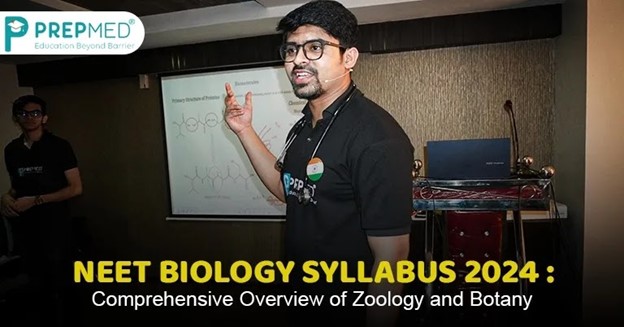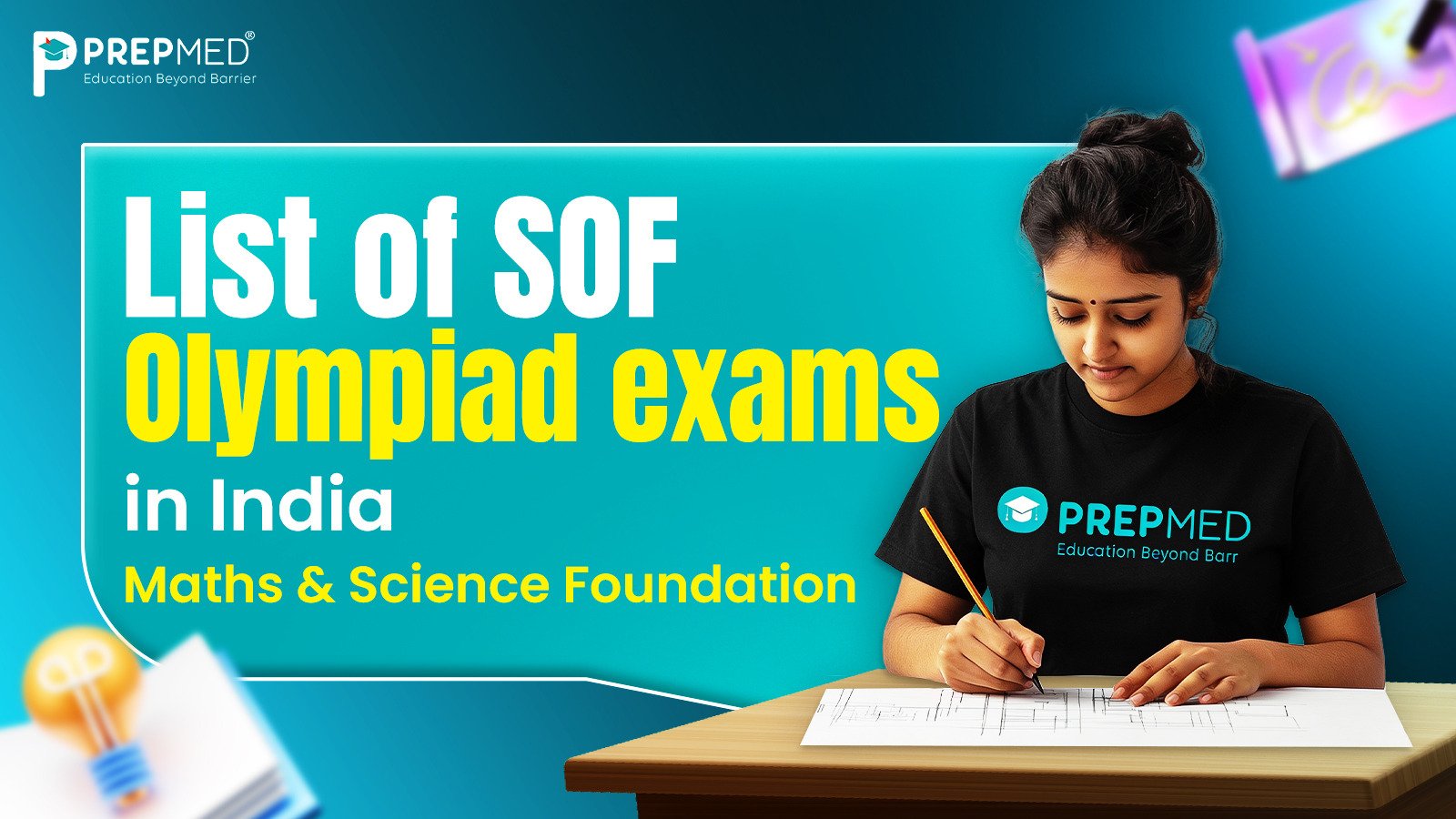June 19, 2024
NEET Biology Syllabus 2024: Comprehensive Overview of Zoology and Botany
In preparation for NEET UG 2024, understanding the NEET Biology syllabus is crucial, encompassing content from both Class 11 and Class 12. Biology holds paramount importance in the NEET 2024 exam, constituting nearly half of the questions.
Prospective candidates are advised to grasp the NEET biology chapter-wise weightage to prioritize key topics. This section comprises a total of 90 questions, spanning both Botany and Zoology.
It’s noteworthy that the NEET Biology syllabus aligns closely with NCERT books, making it essential for aspirants to thoroughly study them. Stay updated with the latest NEET UG 2024 syllabus released by the National Testing Agency (NTA).
NEET UG 2024 Updated Syllabus Highlights:
Biology dominates the NEET UG exam, contributing significantly to the overall score. The NTA NEET Biology section primarily features simple, concept-based questions, rewarding strategic study efforts.
As of November 22, 2023, the NEET 2024 Syllabus was updated on the official NTA website, with a few topics added and removed. It’s imperative for students to download the updated NEET Biology Syllabus 2024 to align their preparation accordingly.
NEET Biology Syllabus 2024 Overview:
The NEET Biology syllabus for 2024 encompasses two branches—Botany and Zoology. Botany delves into the study of plant life, while Zoology explores animal biology.
Designed to assess candidates on Class 11 and Class 12 topics, the syllabus is extensive, necessitating a thorough understanding. Below, we provide a topic-wise breakdown of the NEET Biology syllabus, including both Zoology and Botany.
NEET Biology Syllabus 2024 for Class 11:
An essential component of NEET preparation, the Class 11 syllabus outlines key topics and subtopics, offering a comprehensive overview for effective study.
NEET Biology Syllabus 2024 Class 11:
Diversity in the Living World
1. What is living?
- Biodiversity
- Need for classification
- Three domains of life.
- Taxonomy & Systematics.
- Concept of species and taxonomical hierarchy; Binomial nomenclature.
- Tools for study of Taxonomy – Museums, Zoos, Herbaria.
- Botanical gardens.
2. Five kingdom classification
- Salient features and classification of Monera.
- Protista and Fungi are into major groups; Lichens; Viruses and Viroids.
3. Salient features and classification of plants into major groups
- Bryophytes,
- Pteridophytes,
- Gymnosperms and Angiosperms (three to five salient and distinguishing features and at least two examples of each category);
- Angiosperms- classification up to class, characteristic features, and examples).
4. Salient features and classification of animals-nonchordate up to phyla level and chordate up to class level (three to five salient features and at least two examples).
Structural Organization in Animals and Plants:
1. Morphology and modifications
- Tissues,
- Anatomy and functions of different parts of flowering plants: Root, stem, leaf, inflorescence- cymose and racemose, flower, fruit, and seed (To be dealt with along with the relevant practical of the Practical Syllabus).
2. Animal tissues; Morphology, anatomy, and functions of different systems (digestive, circulatory, respiratory, nervous, and reproductive) of an insect (cockroach). (Brief account only)
Cell Structure and Function
1. Cell theory and cell as the basic unit of life
- Structure of prokaryotic and eukaryotic cells
- Plant cell and animal cell; Cell envelope, cell membrane, cell wall;
- Cell organelles-structure and function; Endomembrane system-endoplasmic reticulum,
- Golgi bodies, lysosomes, vacuoles;
- mitochondria, ribosomes, plastids, microbodies; Cytoskeleton, cilia, flagella, centrioles (ultrastructure and function); Nucleus-nuclear membrane, chromatin, nucleolus.
2. Chemical constituents of living cells:
- Biomolecules-structure and function of proteins, carbohydrates, lipids, nucleic acids; Enzymes-types, properties, enzyme action.
3. B Cell division: Cell cycle, mitosis, meiosis, and their significance
Plant Physiology
1. Transport in plants: Movement of water, gasses and nutrients
- Cell to cell transport-Diffusion, facilitated diffusion, active transport;
- Plant–water relations – Imbibition, water potential, osmosis, plasmolysis;
- Long-distance transport of water – Absorption, apoplast, symplast, transpiration pull, root pressure, and guttation;
- Transpiration-Opening and closing of stomata;
- Uptake and translocation of mineral nutrients-Transport of food, phloem transport, Mass flow hypothesis;
- Diffusion of gasses (brief mention).
2 Mineral nutrition: Essential minerals, macro, and micronutrients, and their role
- Deficiency symptoms.
- Mineral toxicity;
- Elementary idea of Hydroponics as a method to study mineral nutrition;
- Nitrogen metabolism-Nitrogen cycle, biological nitrogen fixation.
3 Photosynthesis:
- Photosynthesis as a means of Autotrophic nutrition; Site of photosynthesis takes place.
- pigments involved in Photosynthesis (Elementary idea).
- Photochemical and biosynthetic phases of photosynthesis.
- Cyclic and noncyclic and photophosphorylation; Chemiosmotic hypothesis.
- Photorespiration C3 and C4 pathways; Factors affecting photosynthesis.
4. Respiration:
- Exchange gasses;
- Cellular respiration-glycolysis, fermentation (anaerobic),
- TCA cycle and electron transport system (aerobic); Energy relations of ATP molecules generated;
- Amphibolic pathways; Respiratory quotient.
5. Plant growth and development:
- Seed germination
- Phases of Plant growth and plant growth rate
- Conditions of growth
- Differentiation, differentiation, and redifferentiation; Sequence of developmental process in a plant cell
- Growth regulators-auxin, gibberellin, cytokinin, ethylene, ABA
- Seed dormancy
- Vernalisation
- Photoperiodism
Human Physiology
1. Digestion and absorption
- Alimentary canal and digestive glands;
- Role of digestive enzymes and gastrointestinal hormones;
- Peristalsis, digestion, absorption, and assimilation of proteins, carbohydrates, and fats;
- The caloric value of proteins, carbohydrates, and fats; Egestion;
- Nutritional and digestive disorders – PEM, indigestion, constipation, vomiting, jaundice, diarrhea.
2. Breathing and Respiration:
- Respiratory organs in animals (recall only);
- Respiratory system in humans; Mechanism of breathing and its regulation in humans-Exchange of gasses, transport of gasses and regulation of respiration Respiratory volumes;
- Disorders related to respiration-Asthma, Emphysema, Occupational respiratory disorders.
3. Body fluids and circulation:
- Composition of blood, blood groups, coagulation of blood;
- Composition of lymph and its function;
- Human circulatory system structure of the human heart and blood vessels;
- Cardiac cycle, cardiac output, ECG, Double circulation;
- Regulation of 38 cardiac activity;
- Disorders of circulatory system-Hypertension, Coronary artery disease, Angina pectoris, Heart failure.
4. Excretory products and their elimination:
- Modes of excretion- Ammonotelism, ureotelism, uricotelism;
- Human excretory system structure and function;
- Urine formation, Osmoregulation;
- Regulation of kidney function-Renin-angiotensin, Atrial Natriuretic Factor, ADH and Diabetes insipidus; Role of other organs in excretion;
- Disorders;
- Uraemia, Renal failure, Renal calculi, Nephritis; Dialysis, and artificial kidney.
5. Locomotion and Movement:
- Types of movement- ciliary, flagellar, muscular; Skeletal muscle- contractile proteins and muscle contraction,
- Skeletal system and its functions (To be dealt with in the relevant practical of Practical syllabus),
- Joints,
- Disorders of muscular and skeletal system-Myasthenia gravis,
- Tetany,
- Muscular dystrophy,
- Arthritis,
- Osteoporosis,
- Gout.
6. Neural control and coordination:
- Neuron and nerves;
- Nervous system in humans- central nervous system, peripheral nervous system, and visceral nervous system;
- Generation and conduction of nerve impulse; Reflex action;
- Sense organs;
- Elementary structure and function of eye and ear.
7. Chemical coordination and regulation:
- Endocrine glands and hormones;
- Human endocrine system-Hypothalamus, Pituitary, Pineal, Thyroid, Parathyroid, Adrenal, Pancreas, Gonads;
- Mechanism of hormone action (Elementary Idea); Role of hormones as messengers and regulators, Hypo-and hyperactivity and related disorders (Common disorders, e.g. Dwarfism, Acromegaly, Cretinism, goiter, exophthalmic goiter, diabetes, Addison’s disease).
- (Imp: Diseases and disorders mentioned above to be dealt with briefly.)
NEET Biology Syllabus 2024 for Class 12:
- Building on Class 11 concepts, the Class 12 syllabus delves deeper into advanced topics, including human reproduction, evolution, ecology, biotechnology, and genetics.
NEET Biology Syllabus For Class 12
Reproduction
- Reproduction in organisms: Reproduction, is a characteristic feature of all organisms for the continuation of species
- M1odes of reproduction – Asexual and sexual
- Asexual reproduction; Modes-Binary fission, sporulation, budding, gemmule, fragmentation
- vegetative propagation in plants.
1. Sexual reproduction in flowering plants:
- Flower structure; Development of male and female gametophytes;
- Pollination types, agencies, and examples;
- Outbreeding devices
- Pollen-Pistil interaction
- Double fertilisation
- Post fertilization events-Development of endosperm and embryo, Development of seed, and formation of fruit
- Special modes-apomixis, parthenocarpy,
- polyembryony
- Significance of seed and fruit formation.
2. Human Reproduction:
- Male and female reproductive systems;
- Microscopic anatomy of testis and ovary; Gametogenesis-spermatogenesis & oogenesis;
- Menstrual cycle;
- Fertilization, embryo development up to blastocyst formation, implantation;
- Pregnancy and placenta formation (Elementary idea);
- Parturition (Elementary idea); Lactation (Elementary idea).
3. Reproductive health:
- Need for reproductive health and prevention of sexually transmitted diseases (STD);
- Birth control and Methods, Contraception and Medical Termination of Pregnancy (MTP); Amniocentesis;
- Infertility and assisted reproductive technologies – IVF, ZIFT, GIFT (Elementary idea for general awareness).
Genetics and Evolution
1. Heredity and variation:
- Mendelian Inheritance;
- Deviations from Mendelism-Incomplete dominance, Co-dominance, Multiple alleles and Inheritance of blood groups, Pleiotropy; Elementary idea of polygenic inheritance; Chromosome theory of inheritance; Chromosomes and genes;
- Sex determination-In
- humans, birds, honey bees;
- Linkage and crossing over; Sex-linked inheritance-Haemophilia, Colour blindness; Mendelian disorders in humans-Thalassemia;
- Chromosomal disorders in humans; Down’s syndrome, Turner’s, and Klinefelter’s syndromes.
2. Molecular basis of Inheritance:
- Search for genetic material and DNA as genetic material
- Structure of DNA and RNA; DNA packaging
- DNA replication; Central dogma; Transcription, genetic code, translation
- Gene expression and regulation-Lac Operon
- Genome and Human Genome Project
- DNA fingerprinting.
3. Evolution: Origin of life:
- Biological evolution and evidence for biological evolution from Paleontology, comparative anatomy, embryology, and molecular evidence)
- Darwin’s contribution, Modern Synthetic theory of Evolution; Mechanism of evolution variation (Mutation and Recombination), and Natural Selection with examples and types of natural selection
- Gene flow and genetic drift
- Hardy-Weinberg’s principle
- Adaptive Radiation; Human evolution.
Biology and Human Welfare
1. Health and Disease:
- Pathogens,
- Parasites causing human diseases (Malaria, Filariasis, Ascariasis. Typhoid, Pneumonia, common cold, amoebiasis, ringworm)
- Basic concepts of immunology-vaccines, Cancer, HIV, AIDS Adolescence, drug and alcohol abuse.
2. Improvement in food production:
- Plant breeding, tissue culture, single-cell protein,
- Biofortification; Apiculture and Animal husbandry.
3. Microbes in human welfare:
- In household food processing, industrial production, sewage treatment, energy generation, and as biocontrol agents and biofertilizers.
Biotechnology and Its Applications
1. Principles and process
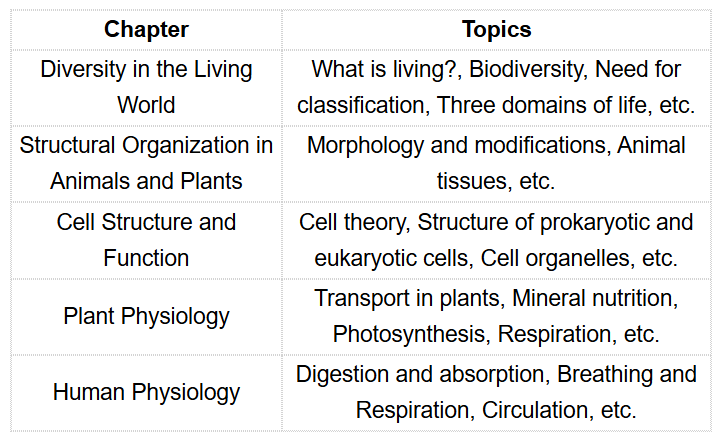
NEET Biology Syllabus 2024 for Class 12
The Class 12 syllabus builds on the concepts from Class 11 and introduces advanced topics that are integral to the NEET UG exam.

NEET Biology Syllabus 2024 Chapter-wise Weightage
Understanding the weightage of each chapter can help you prioritize your study efforts. Below is the chapter-wise weightage for NEET Biology 2024.
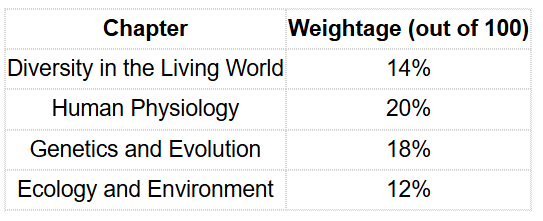
NEET Biology Syllabus 2024 Important Topics
Focus on these key topics to maximize your score in the NEET UG 2024 exam.
Class 11
- Plant Kingdom: Types of algae, Pteridophytes, Gymnosperms
- Biological Classification: Features of Monera, Protista, Fungi
- Cell: Structure & Functions: Nucleus, chromosomes, ribosomes
- Plant Physiology: C3, C4 cycle, Transpiration pull
- Human Physiology: Diagrams and structures are crucial
Class 12
- Reproduction: Gametogenesis, Menstrual cycle, Polyembryony
- Genetics & Evolution: Dihybrid cross, Pedigree analysis
- Biotechnology: Gene therapy, RNAi, BT cotton
- Ecology and Environment: Environmental issues, Population interactions
Best Books for NEET Biology 2024
Selecting the right books is critical for effective preparation. Here are some of the recommended books for NEET Biology 2024.
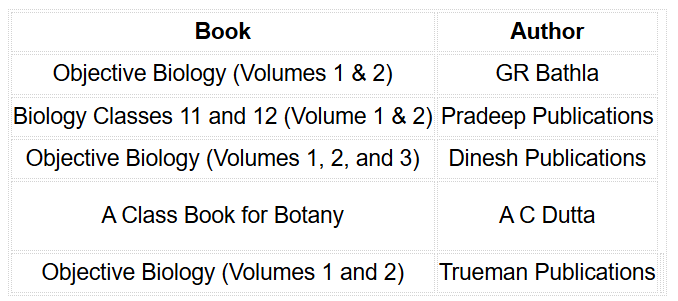
NEET Biology Syllabus 2024 Preparation Tips:
To navigate the extensive syllabus effectively, follow these preparation tips for NEET Biology 2024:
- Prioritize the NCERT biology textbook.
- Thoroughly cover all important topics.
- Practice questions from the NEET Biology syllabus.
- Focus on human physiology, plant physiology, reproduction, genetics, and ecology.
- Enhance speed and accuracy through NEET 2024 mock tests.
Prepare strategically, stay focused, and ace the NEET UG 2024 Biology section with confidence
